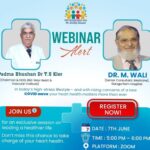“Mass awareness on how to do CPR and access to external defibrillators essential for saving lives”
New Delhi, September 26, 2018:
A recent study called the Cardiac Arrest Resuscitation Outcome or CARO has indicated that of the 56.5% of out of hospital cardiac arrest (OHCA) events witnessed by bystanders about 92.5% occur at home. What is alarming is that only 1.3% of those who suffered these arrests received cardio pulmonary resuscitation (CPR) by bystanders. OHCA is one of the leading causes of death in India and the situation is exacerbated by lack of knowledge of CPR and training among bystanders in the community, and absent/ delayed emergency response systems.
CPR is a lifesaving technique useful in many emergencies, including a heart attack or near drowning, in which someone’s breathing, or heartbeat has stopped. This technique along with the access to external defibrillators (devices to restore the normal rhythm of the heart) have the potential to improve outcomes in all patients of cardiac arrest outside the hospital.
Speaking about this, Padma Shri Awardee, Dr K K Aggarwal, President, HCFI, said, “All my life, I have taught medicine in the form of formulas. The CPR 10 was created so that the public could remember the process of cardiopulmonary resuscitation or revival after sudden cardiac death. So, we created a formula of 10 which means that – within 10 minutes of death (earlier the better), at least for the next 10 minutes (longer the better, up to 25 minutes), compress the centre of the chest of the victim with a speed of 10×10 i.e. 100 per minute. There is substantial evidence to suggest that CPR is effective in the first 10 minutes of cardiac arrest. After 10 minutes of death, there is practically no chance of recovery unless patient is in hypothermia. There is also enough evidence that at least 10 minutes of cardiac massage should be given with a speed of 100 per minutes.”
In numerological terms, CPR equates to number 10. In English alphabets, ‘C’ comes at number ‘3’, ‘P’ comes at number ‘16’ and ‘R’ comes at number ‘18’. Adding the three, that is, C=3, P=16, R=18 (3 + 16 + 18 = 37) and, further the two digits in ‘3 + 7’, the total comes to ‘10’. So, ‘CPR 10’ should be an effective way to remember.
Adding further, Dr Aggarwal, who is also the Group Editor-in-Chief of IJCP, said, “Administering CPR is real voluntary work. The CPR 10 Mantra is as follows: Within 10 minutes of cardiac arrest (earlier the better) for the next 10 minutes at least, compress the centre of the chest with a speed of 100 compressions per minute (10×10)”. CPR 10 is easy to learn and easy to do and one does not need to be a doctor or be certified in this technique to do CPR.”
Medtalks. in, a free and complete healthcare learning and patient education platform, includes a chapter on ‘Recommended strategies for prevention of avoidable cardiac arrests and inappropriate CPR attempts. ’Medtalks provides continuous medical education (CMEs), learning and information to stakeholders including doctors, paramedics, nurses, allied healthcare workers, and patients.
When you come across a victim of cardiac arrest, three simple rules must be followed: Call the ambulance, check if the person is breathing or has a pulse and if not, then start chest compressions and continue for at least 30 minutes till medical help arrives. It is also imperative to not stop CPR too soon. The premise of a successful cardiopulmonary resuscitation (CPR) is earlier the better and longer the better. Discussion on CPR will be an integral part of the 25th MTNL Perfect Health Mela to be held between 23rd and 27thOctober 2018 at the Talkatora Indoor Stadium, New Delhi.







